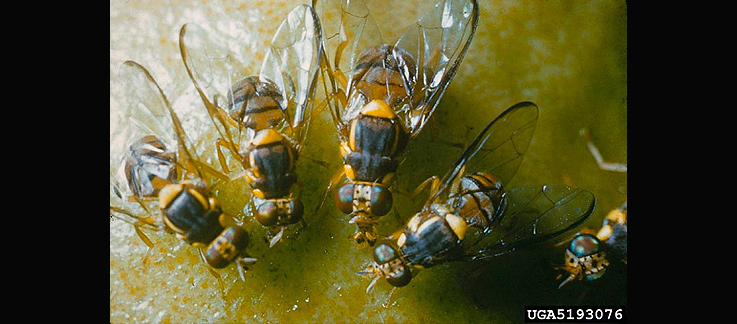This is a continuously updated post to follow up on our previous post, Unusually High Exotic Fruit Fly Season in California
If you encounter an Exotic Fruit Fly:
- Call the CDFA Exotic Pest Hotline at 1 (800) 491-1899.
- Do not collect the specimen yourself. Rather, contact your local ag commissioners office, they will collect the sample and coordinate with CDFA.
- Find your local ag commissioner here.
- See below for Pest Profiles and Quarantine Boundaries of Exotic Fruit Flies with active quarantines in California.
Background:
California is experiencing an unusually high population of exotic fruit flies this season. The California Department of Food and Agriculture (CDFA) has issued local quarantine and eradication measures to prevent statewide spread of the Queensland Fruit Fly, Tau Fly, Mediterranean Fruit Fly, and Oriental Fruit Fly.
Exotic Fruit Fly numbers are monitored by identifying adults that are captured in traps placed around the state and counted. If exotic fruit flies were to become established in California, USDA may enact regional or statewide quarantines. This can be costly and will negatively impact growers. Additionally, crop losses due to these pests are a significant concern.
Impacted Regions:
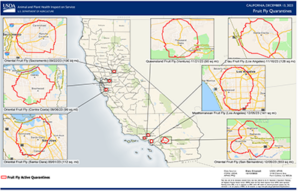
Regulation, monitoring, and quarantine boundaries are updated by CDFA as specimens are found throughout the state. These measures are necessary to eradicate Exotic Fruit Flies and are critical in protecting California’s agricultural industry.
Updated maps of all quarantine boundaries for all Exotic Fruit Flies can be found in the individual pest profiles below. Map links are updated as quarantine boundaries are expanded. To identify which crops are hosts for specific Exotic Fruit Flies, see full list here.
Latest Updates
January 18, 2024, Update:
The MedFly Quarantine Boundary has been expanded in the Los Angeles County – Leimert Park Area.
A map of the proposed boundary can be found here.
December 22, 2023, Update:
The Oriental Fruit Fly Quarantine Boundary has been expanded in the San Bernardino County – San Bernardino area.
A map of the proposed boundary can be found here.
December 11, 2023, Update:
The MedFly Quarantine Boundary has been expanded in the Los Angeles County – Los Angeles Area.
A map of the proposed boundary can be found here.
December 6, 2023, Update:
The Oriental Fruit Fly Quarantine Boundary has been expanded in the San Bernardino & Riverside County – Riverside Area.
A map of the proposed boundary can be found here.
The MedFly Quarantine Boundary has been expanded in the Los Angeles County – Los Angeles Area
A map of the proposed boundary can be found here.
November 28, 2023, Update:
The Oriental Fruit Fly Quarantine Boundary has been expanded in the San Bernardino County – Highland and San Bernardino Areas.
A map of the proposed boundary can be found here.
November 27, 2023, Update:
The Queensland Fruit Fly Quarantine Boundary has been expanded in the Ventura County– Thousand Oaks Area.
A map of the proposed boundary can be found here.
November 20, 2023, Update:
The Oriental Fruit Fly Quarantine Boundary has been expanded in the San Bernardino & Riverside – Loma Linda area
A map of the proposed boundary can be found here.
The Tau fly Quarantine Boundary has been expanded in the Los Angeles County– Stevenson Ranch & Santa Clarita areas.
A map of the proposed boundary can be found here.
November 16, 2023, Update:
The MedFly Quarantine Boundary has been expanded in the Los Angeles County Quarantine Boundary.
See updated quarantine area here.
November 9, 2023, Update:
The Oriental Fruit Fly Quarantine Boundary has been expanded in San Bernardino and Riverside Counties, Redlands, Yucaipa, and Moreno Valley Areas.
See updated quarantine area here.
The MedFly Quarantine Boundary has been expanded in the Los Angeles County Quarantine Boundary.
See updated quarantine area here.
To combat the establishment of MedFly (Mediterranean Fruit Fly) colonies in California, sterile insect technique (SIT) is used. The Mediterranean Fruit Fly Preventive Release Program (Medfly PRP) is s a joint program of the United States Department of Agriculture (USDA) and the California Department of Food and Agriculture (CDFA). Sustained releases of large numbers of sterile males into a target area are used to reduce the reproductive potential of wild introductions, to prevent, and eradicate Medfly populations.
The weekly rate of 62,500 to 125,000 of sterile Medflies per square mile over 1,750 square miles, which includes portions of Los Angeles, Orange, San Bernardino, and Riverside counties. Learn more about the Medfly PRP here: https://www.cdfa.ca.gov/plant/PDEP/prpinfo/
November 6, 2023, Update:
The Oriental Fruit Fly Quarantine Boundary has been expanded in San Bernardino and Riverside Counties.
See updated quarantine area here.
November 2, 2023, Update:
The MedFly Quarantine Boundary has been updated to include Los Angeles County – Leimert Park Area.
See updated quarantine area here.
From CDFA: The Mediterranean Fruit Fly (Med Fly) has one of the widest host range of any pest fruit fly, and is considered the most important agricultural pest in the world. It has been recorded infesting over 250 cultivated and wild fruits. The host list includes apple, apricot, avocado, bell pepper, carambola, coffee, dates, fig, grape, grapefruit, guava, lemon, lime, loquat, lychee, mango, nectarine, orange, papaya, peach, pear, persimmon, plum, pomegranate, pummelo, quince, sapote, tangerine, tomato, and walnut. See full list here.
Med Fly Fact Sheet here.
26 October, 2023 Update:
Portions of Ventura and Los Angeles Counties have been placed under quarantine for the Queensland fruit fly (QFF) following the detection of two adult QFFs within the City of Thousand Oaks, in Ventura Count.
Pests
Queensland Fruit Fly
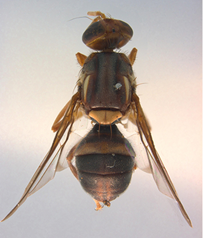
bugwood.org/cdf
- Impacted Crops
- See Crop List
- Quarantine Map
- Description
- The adult female QFF is approximately 6 mm in length, it has a wing expanse of 10 to 12 mm, and it has transparent wings. Body coloration is brown marked with yellow. The dorsum of the thorax has a broad creamy band with a narrow yellow stripe on either side. The abdomen is constricted at the base, and broadly rounded at the tip.
- Pest Profile
- Quarantine Boundaries
Tau Fly
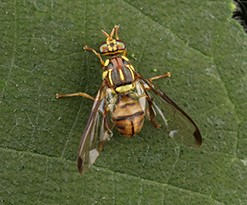
Fan Geo/CDFA
- Impacted Crops
- Tau fly has a broad host range; at least 34 hosts in nine plant families are reported, including melon, okra, peppers, papayas, citrus, cucumber, pumpkin, avocado, tomato, and gourds. It is considered a significant pest of cucurbits.
- Quarantine Map
- Description
- The adult tau fly is approximately 7 mm in length (similar to that of a housefly). The body is yellow with black markings. The clear wings have two dark stripes, one along the front margin that ends in a dark spot and one about half as long running diagonal from the wing base. The female has a pointed slender ovipositor to deposit eggs under the skin of host fruit. The egg is almost one millimeter in length, white, cylindrical, and about four times as long as wide. The larva is creamy-white, legless, and may attain a length of nine millimeters. The pupa is encased in a dark brown cylindrical puparium.
- Pest Profile
- Quarantine Boundaries
Mediterranean Fly
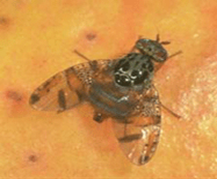
CDFA
- Impacted Crops
- apple, apricot, avocado, bell pepper, carambola, coffee, dates, fig, grape, grapefruit, guava, lemon, lime, loquat, lychee, mango, nectarine, orange, papaya, peach, pear, persimmon, plum, pomegranate, pummelo, quince, sapote, tangerine, tomato, and walnut.
- Quarantine Map
- Description
- The Mediterranean fruit fly is a short, squat fly about 1/4 inch in length. It has a blackish thorax marked with silver; a tan abdomen with darker stripes extending across the abdomen; and clear wings with two light brown bands across the wing, another along the distal front edge, and gray flecks scattered near the base. The immature stages are superficially similar to those of other exotic fruit flies. Eggs are white, very small, elongate, and somewhat banana-shaped. Larvae are white, legless, and somewhat carrot-shaped. The pupa is contained inside an elongate oval, shiny brown, hard puparium.
- Pest Profile
- Quarantine Boundaries
Oriental Fruit Fly
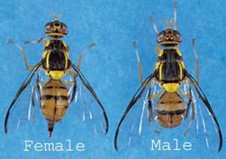
CDFA
- Impacted Crops
- The oriental fruit fly has been recorded from 478 kinds of fruit and vegetables (USDA 2016), including: apricot, avocado, banana, citrus, coffee, fig, guava, loquat, mango, roseapple, papaya, passion fruit, peach, pear, persimmon, pineapple, surinam cherry and tomato. However, avocado, mango and papaya are the most commonly attacked. PDF with species list here.
- Quarantine Map
- Description
- The adult oriental fruit fly is somewhat larger than a housefly, about 8 mm in length. The body color is variable but generally bright yellow with a dark “T” shaped marking on the abdomen. The wings are clear. The female has a pointed slender ovipositor to deposit eggs under the skin of host fruit. Eggs are minute cylinders laid in batches. The maggots (larvae) are creamy-white, legless, and may attain a length of 10 mm inside host fruit.
Impacted Crops
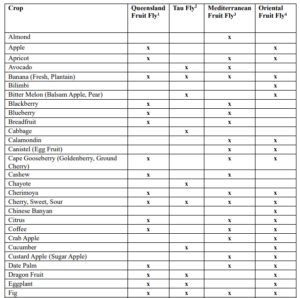
*Avocado has been removed from the OFF host list
Quarantine – The establishment of a quarantine imposes a restriction on movement, possession and sale of commodities covered. Prohibited processing and movement from, within, or across the area under quarantine may require pre- and post-harvest treatments, shipping documents, or other authorization. Exceptions under provisions are specific to each Exotic Fruit Fly species:
- Queensland Fruit Fly: Pg 5, Section D
- Tau Fly: Pg 5, Section D
- Mediterranean Fruit Fly: Pg 12, Section D
- Oriental Fruit Fly: Pg 13, Section D
A quarantine zone is established after emergency response triggers are met.
- USDA APHIS PPQ and state cooperators engage in year-round or seasonal detection trapping for exotic fruit flies. If Exotic Fruit Flies are detected via trapping, subsequent delimitation trapping takes place over a period of time (depending on the species) that would indicate if the EFF detection was a “transient” (non-established) event, or if establishment has occurred via reproduction.
- Triggers for quarantines: Quarantines are triggered after a target number of species detections. Quarantine boundaries are established radiating from each fly found.
- Once a new, exotic fruit fly quarantine is enacted in an area, to halt the movement of all possibly compromised fruit fly host material within the vicinity of the fly found, a Hold Notice is issued to each fly find property, stopping movement of all potentially infested fruit, regardless of whether it was grown or brought into the area.
According to the CDFA Regulatory Response Manual (pg. 14), when a quarantine is established in an agricultural area, a phone tree is set up with all affected growers and establishments to notify them of imminent meetings within the quarantine area, which will provide them with regulatory information and provide each of them with an opportunity to sign a compliance agreement. Additionally, an announcement to states receiving agricultural products from California and a notification to international trading partners may be issued.
HLB (Huanglongbing AKA Citrus Greening) Update:
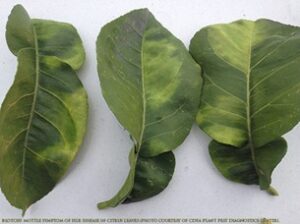 HLB is believed to be caused by a phloem-restricted bacterium which is vectored by the Asian Citrus Psyllid (ACP). HLB has been described as the most devastating disease of citrus in the world. HLB affects almost all citrus cultivars and causes substantial economic and environmental losses to the citrus industry. HLB can be difficult to detect since the host may remain symptomless for months to years before exhibiting symptoms of infection. An early symptom of the disease is blotchy, yellow, asymmetrical mottling of the leaves.
HLB is believed to be caused by a phloem-restricted bacterium which is vectored by the Asian Citrus Psyllid (ACP). HLB has been described as the most devastating disease of citrus in the world. HLB affects almost all citrus cultivars and causes substantial economic and environmental losses to the citrus industry. HLB can be difficult to detect since the host may remain symptomless for months to years before exhibiting symptoms of infection. An early symptom of the disease is blotchy, yellow, asymmetrical mottling of the leaves.
There are currently no curative methods to control HLB and there are no chemical controls that specifically target the bacterium. Thus, comprehensive control measures for HLB focus largely on prevention of infection by eradicating infected plants, controlling the vector, ACP, and the production and planting of HLB-free trees. More information on HLB can be found on the CDFA website here.
An active quarantine is in place for HLB in California. Update map can be found here.
The latest updates from CDFA on HLB regulation and quarantines can be found here.
Resources
- Questions about a fruit fly quarantine/eradication, or possible infestation of fruits and vegetables with fruit fly larvae, call the CDFA Exotic Pest Hotline at 1 (800) 491-1899.
Please consult the CDFA website for official updates on the Exotic Fruit Fly situation in California.
- For updates via ‘X’ (Twitter), follow here.
- For CDFA email updates on specific species, sign up here.*
- For CDFA weekly update meetings, please contact Jeana Cadby ([email protected]) to receive the meeting details.


